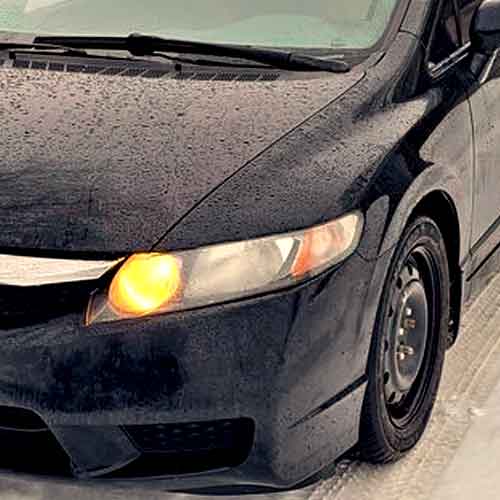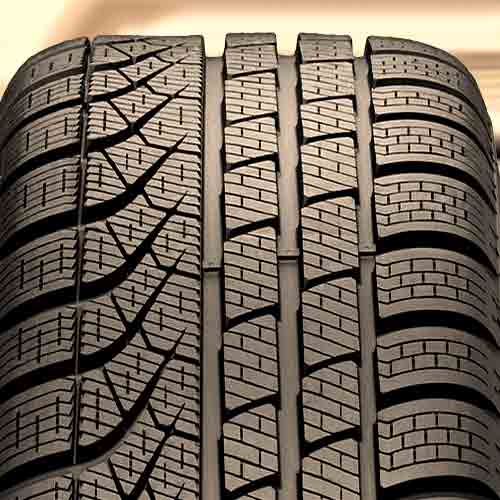As the winter season looms, Pirelli P Zero Winter and Michelin Pilot Alpin 5, both showcasing unique expertise in handling and comfort, provide an array of options for different driving styles. But who will win this winter showdown? Well, let’s find out!

Table of Contents
Key Takeaway
The Pirelli P Zero Winter stands out when it comes to:
- Fuel Economy: The tire’s streamlined longitudinal ribs generate lower rolling resistance values, thus improving energy efficiency and contributing to better fuel economy.
- Ice Performance: The Pirelli shows remarkable performance on icy terrains, delivering shorter average braking distances, due to its detailed biters and an array of slanted incisions.
- Dry Traction: The longitudinal ribs of this tire ensure superior lug-to-road connectivity, resulting in shorter braking distances and improved directional grip.
- Wet Grip: With its multi-angled siping pattern of varied thickness, the P Zero Winter delivers improved overall grip in wet conditions, resulting in shorter braking distances and better lateral traction.
However, the Michelin Pilot Alpin 5 excels in:
- Fluffy Snow Performance: The Michelin provides superior traction on fluffy snow terrains thanks to its unique and slightly more aggressive tread pattern. It efficiently captures and retains fluffy snow particles within its interlocking grooves and snow vices, leading to increased friction and better performance.
- Hydroplaning: The tire’s directional tread pattern, along with its longitudinal running central most channel, effectively displaces water, reducing the risk of hydroplaning and improving performance in wet conditions.
Fuel Economy
The efficiency of fuel consumption is intrinsically linked to the tire’s traction attributes and comprehensive weight – two domains where the Michelin Pilot Alpin 5 displays room for potential enhancements.

This tire’s escalated weight and expansive tread voids propagate increased lug flexing during cornering, braking, and acceleration activities.
It’s greater weight, distributed over a relatively smaller surface area bears a more intensified pressure on the lugs, causing them to bend or mold, consequently, asking for additional energy expenditure.
This energy that’s spent bending the lugs, could otherwise be used in to the rolling of the tire.
That’s why in comparison, the Pirelli P Zero Winter is doing better with it’s relatively more streamlined longitudinal ribs, generating lower rolling resistance values.
In other words, the lugs on this tire aren’t compelled to rub against the road with the same degree of force. The compact tread structure concentrates energy on propelling the entire tire, rather than bending individual blocks, leading to superior energy efficiency.
Ice Performance
Under icy conditions, the Pirelli P Zero Winter boldly asserts its dominance, with an average (7 feet shorter) braking distance compared to its competitor.

So why is the Michelin Pilot Alpin 5 lacking here?
Well, this deficiency can be attributed to the tire’s larger tread voids and fewer notches, which render it less equipped to handle icy conditions.
The central tread area, a crucial component for braking, grapples with gripping packed ice due to the wider lateral tread voids.
Moreover, you also don’t get as aggressive of the overall siping as seen on its counterpart.
On the contrary, the P Zero Winter trumps the competition with its detailed biters spread across the tread.
The tire’s asymmetric pattern combined with a wide array of slanted incisions, combined with multi-angled siping, all contribute to it’s better overall icy terrain performance.
Dry Traction
Dry traction is essentially about the degree of rubber contact with the road, with directional grip and lateral traction playing indispensable roles. Let’s discuss each of these factors in detail.
Directional Grip
The performance of directional grip hinges largely on the central section of the tread. This is because when the tire rolls straight, such as on highways, the majority of the weight it carries concentrates in the central region.
Here, the Pirelli’s longitudinal ribs offer superior lug-to-road connectivity, culminating in shorter braking distances compared to its competitor (a direct measure of directional grip, for the uninitiated).
Conversely, with a directional pattern that includes wider lateral tread voids, (referring to central most circumferential channel), the longitudinal movement of the tread is somewhat restricted, leading to extended braking times.
Handling
Handling performance is primarily influenced by the tire’s shoulder regions and overall weight. As the tire corners, the weight shifts towards the edges of the tread (or shoulders), making their contact with the ground critical.
In this context, the Michelin Pilot Alpin 5, characterized by wider grooves, doesn’t quite meet the performance demonstrated by its counterpart.
Moreover, the additional weight of the tire further compromises overall performance.
This extra weight instigates increased lug movement as the tire maneuvers corners, consequently diminishing steering feedback.
Wet Traction
The performance of a tire in wet conditions is primarily dictated by two pivotal factors: the tread design and the specific rubber compound used in the tire’s construction.
These elements subsequently determine the tire’s grip on wet surfaces and its ability to resist hydroplaning. Let’s start with hydroplaning.
Hydroplaning
Hydroplaning is a phenomenon that occurs when water obstructs the tire tread to properly contact the road. And needless to say, this results in the tire skimming over the water and losing all traction.
And here, the Michelin Pilot has the advantage of having a directional tread pattern with swooping arms, along with longitudinal running central most channel.
Both work in harmony to throw water away from the tread, as it leave out laterally (for the most part), more efficiently.
Here, the Pirelli P Zero Winter, lacks with it’s longitudinal ribs, restricts efficient sideways water displacement, falling behind compared to its competitor.
That’s why although both tires show up with similar straight float speeds, the Pirelli lacks on curved aquaplaning tests.
Wet Grip
Although both tires are fortified with an abundance of siping, given they are winter tires, the Pirelli’s boy still takes away a larger piece of the pie.
This is because wet grip is not just about the number of sipes, but also the type/design too.
And in this regard, with Pirelli adopting multi-angled siping pattern of varied thickness, the tire offers better overall grip, and in all directions too, I should add.
That’s why it features shorter braking distances and lateral traction overall, (as calculated by g forces).
On the other hand, the Michelin Pilot Alpin 5, equipped solely with laterally oriented sipes, slightly under-performs in delivering comprehensive traction. To put simply, this tire lacks because it’s siping isn’t relatively aggressive enough.
Fluffy Snow Performance
When faced with a snowy landscape, both tires exhibit commendable performance. However, if one were to make a choice, the Michelin Pilot Alpin 5 would be the preferred option, especially for navigating fluffier snow terrains.
This superior traction is largely attributed to its unique tread design. The tire features a slightly more aggressive tread pattern with lugs that are spaced apart to interact with the snowy surface effectively.
These tread blocks then establish a snow-to-snow contact, as they efficiently capture and retain fluffy snow particles within their interlocking grooves and snow vices.
This process creates a layer of trapped snow that helps the tread maintain ground contact through this snowy buffer.
Since snow bonds better with itself than with rubber, this results in increased friction.
On the other side, the Pirelli P zero lacks with it’s tighter grooves, and missing swooping arms. So it can’t offer ample snow to snow contact, nor its able to as effectively paddle on this snowy terrain type.
Summing Up
Let’s take it home.
The Michelin Pilot Alpin 5 shines in soft/fluffy snowy conditions due to its distinctive tread design and larger number of tread voids, delivering exceptional snow grip and clearance capabilities. However, when navigating icy terrains, the Pirelli P Zero Winter stands out.
This is because this tire has more biting edges, highly needed on icy terrain traction. And these very biters also help the tire on wet roads.
The same holds true when evaluating dry traction, fuel economy, and tread life, where the Pirelli P Zero Winter comes out on top.